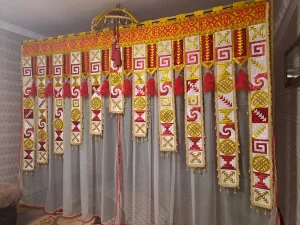




In Kazakh wedding rituals, the obligatory ritual attribute is the shymyldyq (usually a white curtain with embroidery or in mixed techniques). Behind it, the newlywed bride hides in the groom’s house. Shymyldyq weighs up to a year or later it serves as a curtain in front of the bed. The curtain could be part of the bride’s dowry ( zhasau): it was sewn by herself, her mother or a happily married relative of the groom before the wedding. Such a curtain was considered a family heirloom and was passed down from generation to generation. On one of the old copies of the wedding shymyldyq (Akmola Museum of History and Local History) owl feathers – üki – are sewn on.
A similar shymyldyq was practised by the Nogai, and its size was canonical and was 207×60 cm. According to F.Y. Kanokova, the Nogai”shymyldyq” was made “of red cloth or cloth (with lining) in combination with pieces of cloth of different colours (green, blue, white, silver and gold). However, they differed significantly in the decor of the various groups. Karagash-nogai curtains are rich in archaic ornaments embroidered in the technique of gold embroidery. The localised embroideries of Karanogai and Kum Nogai of the previous ethno group were replaced by different coloured patches cut in the shape of a triangle and a square [8, p.25].
On Tajik wedding curtains the whole decor was completed by embroidered congratulatory inscriptions, where the last letters were possibly scribbled rather than embroidered, expressing the magical technique of an unfinished fragment and symbolic of the endless continuation of the good wishes of the young family.
Shymyldyq symbolises the border that hides the face of the bride from prying eyes, a symbolic “refuge” during the first period of marriage, when she is in a “border state”.


